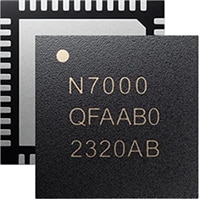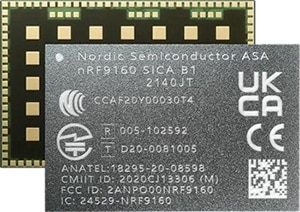Wi-Fi® Locationing Components Overcome GNSS, Cellular Gaps for Positioning Applications
Contributed By DigiKey's North American Editors
2024-08-07
Location-based services can be a powerful advantage in managing assets, but they often come with a significant penalty in battery drain that could effectively cripple some IoT applications. The Global Navigation Satellite System (GNSS) and the broad reach of cellular services provide relatively easy means of determining the geographic position of devices. However, those come with coverage and performance gaps that can be supplemented or, in some cases, replaced by the growing reach of Wi-Fi networks.
The gold standard for wireless tracking is the Global Positioning System (GPS), operated by the U.S., which forms part of the GNSS that encompasses multiple regional satellite navigation systems. However, it can take several minutes for a GPS modem to go from cold start to "time to first fix" (TTFF), all the while utilizing significant battery capacity. It also can be hindered by line-of-sight obstructions between satellites and receivers, including walls of buildings.
Fixed cellular base stations can also be utilized for "locationing" applications. Cellular location scanning utilizes more modest power consumption than with GPS/GNSS, but is less accurate. Cellular locationing, depending on the types of cellular towers being used, might be off by hundreds or even thousands of meters. This lack of precision could be critical for applications such as tracking moving assets in large warehouses or on ocean container ships, for example.
Wi-Fi can be more accurate than cellular locationing and almost as power efficient. The Service Set Identifier (SSID), unique to every Wi-Fi network, and Basic Service Set Identifier (BSSID), unique to each access device, provide an attractive locationing option, but most Wi-Fi integrated circuits are not optimized for the task and are generally costly, bulky, and power-hungry.
Nordic Semiconductor provides components that engineers can use to create flexible applications that rely on combinations of wireless technologies, as well as a cloud-based service, to resolve performance and coverage issues.
The value of Wi-Fi locationing
Locationing can enrich numerous applications, including battery-powered home sensors, health monitors and fitness devices, industrial asset trackers and environmental sensors, and management of retail inventory and point-of-sale devices.
Among leading use cases, businesses can track the location of assets to streamline supply chain management and logistics — wearables can alert medical teams to health issues, retailers and bankers can detect and mitigate fraudulent use of payment cards, and fleet management operators can track their vehicles in real time. Relying on just one wireless technology can be problematic in the case of devices that are not fixed to one location, as GPS, cellular, and Wi-Fi each have strengths and limitations.
Wi-Fi is a simple and cost-effective solution for locationing in use cases where networks and access points are readily available and accessible. Most Wi-Fi devices incorporate some type of locationing, with great variances in the power efficiency and accuracy of implementations.
The Wi-Fi Alliance has taken steps to promote these capabilities and ensure interoperability with its Wi-Fi CERTIFIED Location program that incorporates the IEEE 802.11mc standard. Utilizing the Fine Timing Measurement (FTM) protocol, access points, and wireless LAN cards compliant with Wi-Fi CERTIFIED Location, a location can be determined within a meter, as long as a Wi-Fi access point (AP) knows its exact location.
However, engineers need more compact and energy-efficient components to create cost-effective locationing applications. Efficient power consumption that maximizes battery life is crucial to many IoT devices and sensors. Nordic offers a portfolio of components to leverage Wi-Fi and other positioning options to enhance connectivity of IoT ecosystems.
Wireless companion
The nRF7000 (Figure 1) is a wireless companion IC that is optimized for ultra-low power applications to ensure maximum power efficiency. It does not send data, but instead provides active and passive scanning capabilities to a System on Chip (SoC), Memory Protection Unit (MPU), or Microcontroller Unit (MCU) host for Wi-Fi locationing.
 Figure 1: The nRF7000 low-power Wi-Fi 6 companion IC for Wi-Fi locationing applications. (Image source: Nordic Semiconductor)
Figure 1: The nRF7000 low-power Wi-Fi 6 companion IC for Wi-Fi locationing applications. (Image source: Nordic Semiconductor)
The nRF7000 can scan both the 2.4 GHz and 5 GHz Wi-Fi frequency bands, and it implements the PHY layer and parts of the MAC layer for that purpose. It is connected to a host MCU or application processor—on which the user application executes—through a QSPI (6-wire) or SPI (4-wire) for data, and a 3-wire or 4-wire coexistence control interface for hosts that include a Bluetooth® LE/IEEE 802.15.4 radio.
The nRF7000 is a distilled version of the nRF7002, another companion IC that includes an integrated 2.4 GHz and 5 GHz radio to provide another host chip with direct Wi-Fi 6 data connectivity, as well as locationing capabilities. Also available is the nRF7001, which provides a single-band 2.4 GHz radio. Both are suitable for adding modern Wi-Fi 6 capabilities to existing Bluetooth® Low Energy, Thread®, or Zigbee® systems.
Although each of those devices can be connected to non-Nordic hosts, the company says that with its nRF Cloud platform, it can provide a "silicon-to-cloud locationing solution" with components that support Wi-Fi, cellular, and GNSS positioning.
Getting a Wi-Fi location fix with nRF7000
Nordic’s nRF91 Series cellular system-in-package (SiP) offerings, such as the NRF9160-SICA-B1A-R7 (Figure 2), are designated as the preferred Nordic host devices for the nRF7000/7100/7200 ICs (nRF70 series). These incorporate an application processor and multimode modem in a compact 10 x 16 x 1.04 mm package that supports LTE-M, NB-IoT, GNSS, RF front-end (RFFE), and power management. Other preferred hosts are the Nordic nRF52 and nRF53 series Bluetooth multiprotocol SoCs.
 Figure 2: The nRF9160 SiP with LTE-M/NB-IoT modem and GNSS, which integrates with the nRF7000 to provide seamless locationing applications incorporating Wi-Fi. (Image source: Nordic Semiconductor)
Figure 2: The nRF9160 SiP with LTE-M/NB-IoT modem and GNSS, which integrates with the nRF7000 to provide seamless locationing applications incorporating Wi-Fi. (Image source: Nordic Semiconductor)
An nRF7000 combined with an nRF91 provides accurate Wi-Fi locationing location fixes indoors and outdoors, complementing GNSS and cellular. When the Wi-Fi locationing service is configured, a device can start actively or passively scanning for nearby Wi-Fi access points, collecting data on SSIDs, BSSIDs, and signal strengths.
Using information from the companion IC, an nRF91 can transmit AP information to the nRF Cloud, which uses a Wi-Fi database of known locations to determine an accurate position in relation to at least two nearby APs, without the device having to connect to them. The cloud service can then send the position back to the device or wherever the information is needed. After the location is determined, the device can enter a low-power state to conserve battery power.
The nRF Cloud provides the following alternative options for locationing:
- Assisted GNSS that enables faster TTFF
- Predicted GNSS to provide up to two weeks of predicted satellite data to reduce the frequency of new assistance data requests
- Single-cell location (SCELL) to provide coarse locations based on the nearest cell, eliminating the need for the GNSS receiver
- Multi-cell location (MCELL) also provides a more accurate but still coarse location utilizing the nearest cell and neighboring cells
Each of these location processes in the nRF Cloud provides different characteristics for position accuracy and power consumption. According to Nordic, Wi-Fi delivers location accuracy of 5 m to 15 m, compared to 5 m to 10 m with GNSS, 200 m to 300 m for multi-cell cellular, and 1,000 m for single cell. Latency is lowest for cellular at less than 1 second, while it takes seconds for both GNSS and Wi-Fi. Power consumption tests by Nordic showed a slight edge to cellular at 122.48 mC, compared to 125.85 mC for Wi-Fi and 316.71 mC for GNSS utilizing A-GPS.
Nordic offers several tools, including its nRF Connect SDK software development environment for all nRF70 series devices, as well as the nRF7002 EK dual-band development kit (Figure 3) in an Arduino shield format. The kit incorporates the nRF7002 and can emulate both the nRF7000 and nRF7001, and can be combined with the nRF9160 DK development kit in creating applications utilizing the nRF70 series.
 Figure 3: The nRF7002-EK evaluation kit includes an nRF7002 and can emulate both the nRF7000 and nRF7001. (Image source: Nordic Semiconductor)
Figure 3: The nRF7002-EK evaluation kit includes an nRF7002 and can emulate both the nRF7000 and nRF7001. (Image source: Nordic Semiconductor)
Conclusion
With the nRF7000 and nRF91 Series, Nordic enables developers to create IoT solutions that can leverage multiple wireless technologies for location services. The products offer high performance, low power consumption, and flexible integration options for a wide range of applications that can seamlessly switch between location positioning options.

Disclaimer: The opinions, beliefs, and viewpoints expressed by the various authors and/or forum participants on this website do not necessarily reflect the opinions, beliefs, and viewpoints of DigiKey or official policies of DigiKey.










